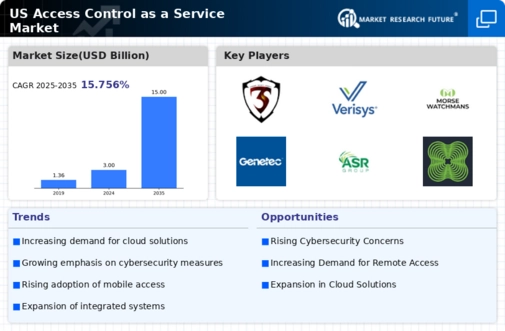Integration with IoT Devices
The integration of Internet of Things (IoT) devices is emerging as a significant driver in the access control-as-a-service market. As more organizations adopt IoT technologies, the need for seamless integration with access control systems becomes paramount. This integration allows for enhanced monitoring and management of access points, providing real-time data and analytics. A recent study suggests that the IoT market is expected to grow by over 25% annually, which will likely influence the access control landscape. By leveraging IoT capabilities, businesses can improve their security posture and operational efficiency, thereby propelling the growth of the access control-as-a-service market.
Rising Cybersecurity Threats
The escalating threat of cyberattacks is a significant driver for the access control-as-a-service market. With data breaches becoming increasingly common, organizations are prioritizing the implementation of advanced security measures. According to recent statistics, nearly 60% of US businesses have experienced a cyber incident in the past year, prompting a reevaluation of their security protocols. This heightened awareness of cybersecurity risks is leading to increased investments in access control solutions that offer enhanced protection against unauthorized access. Consequently, the access control-as-a-service market is witnessing a surge in demand as organizations seek to mitigate these risks and safeguard their assets.
Cost Efficiency and Scalability
Cost efficiency and scalability are crucial factors influencing the access control-as-a-service market. Many organizations are transitioning from traditional security systems to cloud-based solutions due to the lower upfront costs and the ability to scale services according to their needs. A report indicates that businesses can save up to 30% on security expenditures by adopting access control-as-a-service models. This financial incentive, combined with the flexibility to adjust services as organizational needs evolve, is driving the adoption of access control solutions. As companies in the US recognize the long-term savings and operational benefits, the access control-as-a-service market is expected to expand significantly.
Regulatory Compliance Requirements
Regulatory compliance is a critical driver for the access control-as-a-service market. Organizations are increasingly required to adhere to stringent regulations regarding data protection and access control. For instance, industries such as healthcare and finance face rigorous compliance standards that mandate secure access to sensitive information. As a result, businesses are turning to access control-as-a-service solutions to ensure they meet these regulatory requirements effectively. The market is likely to see continued growth as companies invest in systems that not only enhance security but also facilitate compliance with evolving regulations, thereby reducing the risk of penalties and reputational damage.
Growing Demand for Remote Access Solutions
The increasing need for remote access solutions is a pivotal driver in the access control-as-a-service market. Organizations are increasingly adopting remote work policies, necessitating secure access to facilities and data from various locations. This trend is reflected in a survey indicating that over 70% of companies in the US have implemented or are planning to implement remote access solutions. As a result, the demand for access control systems that can facilitate secure remote access is surging. This shift not only enhances operational flexibility but also drives the growth of the access control-as-a-service market, as businesses seek to ensure that their security measures are robust enough to handle remote access without compromising safety.
























Leave a Comment